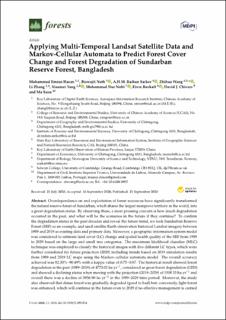| dc.contributor.author | Hasan, Mohammad Emran | |
| dc.contributor.author | Nath, Biswajit | |
| dc.contributor.author | Sarker, Abul Hasnat Mohammad Raihan | |
| dc.contributor.author | Wang, Zhihua | |
| dc.contributor.author | Zhang, Li | |
| dc.contributor.author | Yang, Xiaomei | |
| dc.contributor.author | Nobi, Mohammad Nur | |
| dc.contributor.author | Røskaft, Eivin | |
| dc.contributor.author | Chivers, David J. | |
| dc.contributor.author | Suza, Ma | |
| dc.date.accessioned | 2022-06-27T09:15:05Z | |
| dc.date.available | 2022-06-27T09:15:05Z | |
| dc.date.created | 2021-01-07T13:59:30Z | |
| dc.date.issued | 2020 | |
| dc.identifier.citation | Forests. 2020, 11 1016-?. | en_US |
| dc.identifier.issn | 1999-4907 | |
| dc.identifier.uri | https://hdl.handle.net/11250/3001024 | |
| dc.description.abstract | Overdependence on and exploitation of forest resources have significantly transformed the natural reserve forest of Sundarban, which shares the largest mangrove territory in the world, into a great degradation status. By observing these, a most pressing concern is how much degradation occurred in the past, and what will be the scenarios in the future if they continue? To confirm the degradation status in the past decades and reveal the future trend, we took Sundarban Reserve Forest (SRF) as an example, and used satellite Earth observation historical Landsat imagery between 1989 and 2019 as existing data and primary data. Moreover, a geographic information system model was considered to estimate land cover (LC) change and spatial health quality of the SRF from 1989 to 2029 based on the large and small tree categories. The maximum likelihood classifier (MLC) technique was employed to classify the historical images with five different LC types, which were further considered for future projection (2029) including trends based on 2019 simulation results from 1989 and 2019 LC maps using the Markov-cellular automata model. The overall accuracy achieved was 82.30%~90.49% with a kappa value of 0.75~0.87. The historical result showed forest degradation in the past (1989–2019) of 4773.02 ha yr−1, considered as great forest degradation (GFD) and showed a declining status when moving with the projection (2019–2029) of 1508.53 ha yr−1 and overall there was a decline of 3956.90 ha yr−1 in the 1989–2029 time period. Moreover, the study also observed that dense forest was gradually degraded (good to bad) but, conversely, light forest was enhanced, which will continue in the future even to 2029 if no effective management is carried out. Therefore, by observing the GFD, through spatial forest health quality and forest degradation mapping and assessment, the study suggests a few policies that require the immediate attention of forest policy-makers to implement them immediately and ensure sustainable development in the SRF. | en_US |
| dc.language.iso | eng | en_US |
| dc.publisher | MDPI | en_US |
| dc.rights | Navngivelse 4.0 Internasjonal | * |
| dc.rights.uri | http://creativecommons.org/licenses/by/4.0/deed.no | * |
| dc.title | Applying Multi-Temporal Landsat Satellite Data and Markov-Cellular Automata to Predict Forest Cover Change and Forest Degradation of Sundarban Reserve Forest, Bangladesh | en_US |
| dc.title.alternative | Applying Multi-Temporal Landsat Satellite Data and Markov-Cellular Automata to Predict Forest Cover Change and Forest Degradation of Sundarban Reserve Forest, Bangladesh | en_US |
| dc.type | Peer reviewed | en_US |
| dc.type | Journal article | en_US |
| dc.description.version | publishedVersion | en_US |
| dc.source.pagenumber | 1016-? | en_US |
| dc.source.volume | 11 | en_US |
| dc.source.journal | Forests | en_US |
| dc.identifier.doi | 10.3390/f11091016 | |
| dc.identifier.cristin | 1867098 | |
| cristin.ispublished | true | |
| cristin.fulltext | original | |
| cristin.qualitycode | 1 | |

